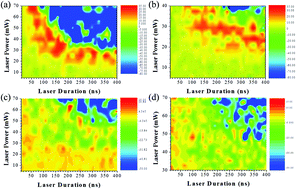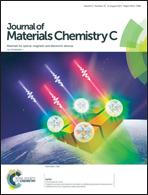Effects of resonant bonding and structural distortion on the phase change properties of Sn2Sb2Se5†
Abstract
The phase-change characteristics of Sn2Sb2Se5 (SSS), a pseudo-binary chalcogenide material, were investigated for use in phase-change random access memory applications. Although an analysis of the power and phase-change speed using laser static test equipment showed superior phase-change properties, several instabilities existed during the phase-change process. It was also found that the difference in resistivity between the crystalline and amorphous structures was high, as compared to conventional Ge2Sb2Te5 (GST). The SSS material also required a higher set/reset switching power than GST in electrical pulse switching tests. Based on extended X-ray absorption fine structure measurements and ab initio calculations of the charge distribution, short and long bonds were not found to co-exist around the Sn atoms, unlike the Ge atoms in GST. This evidence leads to enhanced resonant bonding in SSS, which prevents the Sn atoms from participating in the Ge-like phase-change mechanism. While the Ge atoms in crystalline GST tend to occupy defective octahedral sites, the Sn atoms in SSS prefer a tightly bonded resonant bonding state with a six-fold geometry. This strong resonant bonding results in a lack of Peierls-like distortion in the SSS structure. As a result, the competition between Peierls-like distortion and resonant bonding significantly affects the phase-change characteristics such as the SSS instability and switching process.



 Please wait while we load your content...
Please wait while we load your content...